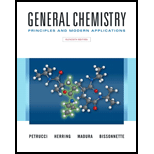
Concept explainers
(a)
Interpretation:
To write the rate expression for the reaction.
Concept introduction:
The given E1 reaction is as follows:
(b)
Interpretation:
To draw the reaction profile of the reaction.
Concept introduction:
Potential-energy profile diagram describe mechanism of a reaction. This diagram shows the changing potential energy between reactant and product that occur during a
(c)
Interpretation:
To write the effect on the reaction on doubling the concentration of
Concept introduction:
In E1 reaction rate depends on the concentration of substrate. The substrate is directly proportional to the reaction rate. So, rate of the reaction becomes doubled when concentration of
(d)
Interpretation:
To write the effect on the reaction on double the concentration of
Concept introduction:
In E1 reaction rate depends on concentration of substrate not in the concentration of
Want to see the full answer?
Check out a sample textbook solution
Chapter 27 Solutions
GENERAL CHEMISTRY-MOD.MASTERINGCHEM.
- Give the rate equation for reactant A in the reaction A(s) > B(g) + C(g)arrow_forward10 What is the rate of reaction when the transition state free energy is 22.84 kJ/mol? What is the rate of reaction when the transition state free energy is 142 kJ/mol? SHOW YOUR WORK.arrow_forwardA haloalkane reacts with a strong base to yield only one alkene product. Select the possible structures that can give this result from Figure 9. * A B C Darrow_forward
- 1. which one is the starting material 2. what is the product/reaction 3. is it sn1 or sn2? (what is the reaction rate equation and mechanism?)arrow_forward19. Which of the following represents the transition state of the rate-determining step in the SN1 reaction between tert-butyl chloride and water? (see attached screenshot) A. 1 B. 2 C. 3 D. 4arrow_forwardThe rate law for the reaction of HO- with tert-butyl bromide to form an elimination product in 75% ethanol/25% water at 30 °C is the sum of the rate laws for the E2 and E1 reactions. What percentage of the reaction takes place by an E2 pathway when [HO-] = 5.0 M? (k2 = 7.1 * 10 - 5, and k1 = 1.5 * 10 - 5) rate = rate law for the E2 reaction + rate law for the E1 reation rate = k2 3tert@butyl bromide43HO-4 + k1 3tert@butyl bromide4arrow_forward
- E 21 write mechanisms for the given reactionsarrow_forwardThe rate law for the reaction of HO- with tert-butyl bromide to form an elimination product in 75% ethanol/ 25% water at 30 °C is the sum of the rate laws for the E2 and E1 reactions. What percentage of the reaction takes place by an E2 pathway when [HO-] = 5.0 M? (k2 = 7.1 x 10-5, and k1 = 1.5 x 10-5)arrow_forwardDraw an energy diagram for the SN2 reaction on the previous page. Your reaction coordinate diagram should: Include structures of starting materials, products, and transition states at correct relative energies. Indicate the activation energy of the rate determining step and whether the reaction is endothermic or exothermic. What makes this reaction endothermic or exothermic?arrow_forward
- Target reaction: WO3 (s) + 3 H2 (g) → W (s) + 3 H2O (g) Reaction 1: W (s) + 3/2 O2 (g) → WO3 (s) Reaction 2: H2 (g) + 1/2 O2 (g) → H2O (g) How are these two given reactions arranged to obtain the target one? Group of answer choices A)(1)(Rxn1) + (3)(Rxn 2) B)(–1)(Rxn 1) + (3)(Rxn 2) C)(3)(Rxn 1) + (–1)(Rxn 2) D)(–1)(Rxn 1) + (–3)( Rxn 2) E)(1)(Rxn 1) + (1)(Rxn 2)arrow_forwardWhat happens to the rate of an SN2 reaction under the following conditions? [RX] is halved, and [:Nu−] is doubled.arrow_forwardIn the reaction from compound 10 to compound 11, why the C=C bond is retained and is not hydrogenated? f) LiAlH4, Et2O, 08C; g) Ac2O, py, DMAP, CH2Cl2, RT, 77% over 2 steps;arrow_forward
 Organic Chemistry: A Guided InquiryChemistryISBN:9780618974122Author:Andrei StraumanisPublisher:Cengage Learning
Organic Chemistry: A Guided InquiryChemistryISBN:9780618974122Author:Andrei StraumanisPublisher:Cengage Learning
 Organic ChemistryChemistryISBN:9781305580350Author:William H. Brown, Brent L. Iverson, Eric Anslyn, Christopher S. FootePublisher:Cengage Learning
Organic ChemistryChemistryISBN:9781305580350Author:William H. Brown, Brent L. Iverson, Eric Anslyn, Christopher S. FootePublisher:Cengage Learning


